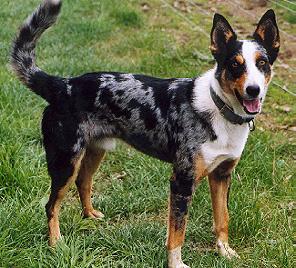The Koolie has been around since the 1800’s and is one of Australia’s oldest breeds. This is a herding breed, through and through! Able to work any type of animal and in all manner of situations, they are also adaptable for many different dog sports and activities as well. They can excel in tracking, obedience, agility, trieball, flyball and canine freestyle. In addition they can also make excellent therapy dogs, service dogs, search and rescue dogs or even explosive detection dogs! Overall this is a hard working and talented breed that also doubles as a great pet for those who can meet their needs.
The Koolie is an extremely active breed, not only physically but also mentally. While many herding breeds were developed to have intense stamina, the Koolie was also developed to be extremely intelligent and focused as well. This means that not only must the amount of exercise be upped, but also the amount and intensity of training. The Koolie lives to work and he especially enjoys challenging mental exercise. He loves to solve puzzles, make his owner happy, and learn! This is a dream-come-true for experienced owners who want to push their training limits with a dog, but a nightmare for someone who can’t or won’t dedicate lots of time to the process. Koolies that aren’t trained regularly quickly become extremely frustrating to live with because they need an outlet for their brain. Not only can they become bored and destructive, but also tend to take over the household and make their own rules!
At this time there is no official breed standard for the Koolie as most breeders agree the working qualities should come first. Ears can be either pricked, semi-pricked or hanging. Coats can appear as anything from very smooth to fairly long, and come in a variety of colors. Eyes can also be seen in a number of colors or even be split-color. Size and weight also has quite a bit of variation. Although there is no formal standard, there are guides and outlines detailing the most important points that breeders should be striving for, along with the possibility that a more detailed standard may come later. But for now there is a wide variation in appearance, with regional styles tying into the particular conditions in which the dogs work. For example, a cold weather region where dogs are expected to work tough cattle will likely house Koolies that have longer, thicker fur and a sturdier build. 
Koolies tend to get along well with other pets and animals, although may need a bit of guidance at first from their owners to ensure they play nicely. This is a devoted and dedicated breed when it comes to their human family and they want nothing more than to please. They are often gentle and patient with children (although it is important to supervise the interactions with very young children). People-loving, they do best with owners that are home frequently or are able to take the dog to work with them. This is a loyal and social dog.
The Koolie is moderately active indoors and very active outdoors, which means he needs a home with a large backyard to run in. It was mentioned once and it’s worth mentioning again… this dog does best with very active owners who are able to give the dog plenty of exercise! He is not a couch potato, nor is he a dog that will do well on only one short walk a day. He needs to move, move, move!
While most Koolies are healthy, there are some genetic problems that a prospective buyer should be on the lookout for. As is the case with all breeds that come in a merle pattern, merle dogs should never be bred together with each other because the resulting puppies could be born blind, deaf or both! A responsible breeder will never even attempt this type of mating but naive or irresponsible breeders may not know any better. Merle Koolies should only be bred to solid-colored Koolies! Allergies and other immune-related conditions are also occasionally seen in the breed. Overall, however, this rare breed has a large gene pool and most individual dogs remain healthy. The average lifespan is 16-18.
